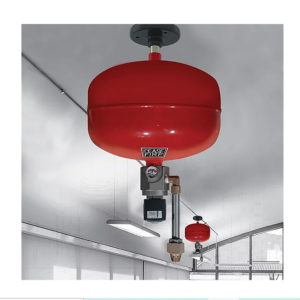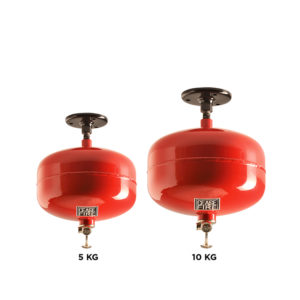Description
- Greenest, Most Natural & Sustainable Fire Suppression Systems
- Uses Natural gasses including Nitrogen, Argon, CO2 and their blends as extinguishing agents
- Extinguishes fire by reducing the concentration of Oxygen in the fire zone.
- Electronics and environment friendly
- VDS approved system
Product Overview
Ceasefire inert gas suppression system uses inert or natural gases to extinguish fires. Often used as a blend of gases, these gaseous mixtures leave no residue behind and are designed to protect enclosures where there is a need for quick reaction to extinguishing a fire. A fire detection module is an integral part of these systems to trigger the gas suppression system.
The Basic Premise
The idea behind Ceasefire Inert Gas Fire System is to reduce the amount of oxygen present in the area where the fire breaks out. This is important because fires need oxygen in order to spread. Remove this vital element and the fire will be easier to contain.
While the oxygen level is lowered, the system does not eliminate oxygen from the space altogether. There is still enough Oxygen present to support proper breathing, as anyone in the immediate area moves along the escape route and exits the room.
What gases are used?
Ceasefire Inert Gas Suppression Systems use the following gases that reduce the concentration of Oxygen in the fire zone to kill fires. These included:
- CF1: CO2 (100%)
- CF100: Nitrogen (100%)
- CF541: A blend of Nitrogen(50%) + Argon(40%) + C02(10%)
- CF01: Argon (100%)
- CF55: A mix of Argon(50%) + Nitrogen(50%)
These inert gases are naturally occurring gases. We are surrounded by these gases. These gases reduce concentration of oxygen in the given space and extinguishes fire.
How is the Gas Deployed?
The Ceasefire Gaseous Fire Suppression systems can be configured for unique gas discharge options. Typically class “C” electrical fires require a minimum concentration while class “B” flammable liquid fires require a higher concentration or lowering of oxygen levels to put the fire out. Settling on the right approach depends on the type of environment in which the system will be used.
How does the system work?
The air we breathe has approximately 21% of Oxygen. Oxygen is the key factor in sustaining a fire and the key factor in keep us alive too!
By removing the oxygen, we will certainly extinguish a fire, but that comes with obvious problems. How do we sustain life at the same time?
Fires need more than 16% Oxygen to combust. Anything below this level of oxygen will not be enough for a fire to sustain combustion.
Product Features
Absolutely safe on Environment: The system uses inert / non-reactive gases as the extinguishing agent and hence is completely environment friendly.
Electronics friendly: Inert gases leave no residue behind and is completely safe on electronics.
Zero Toxicity: Inert gases do not react with fire to emit toxic fumes or by-products of any kind.
Uniform Discharge Flow: The system’s constant pressure regulation feature ensures discharge of the agent gases at uniform pressure throughout the operation, adding to the system’s effctiveness.
Real Time Design Support: Ceasefire in-house Design Cell offers end-to-end design support to customise the system for any kind of a premises.
Scalable: The system is scalable to a 240 cylinder installation for extremly high volume protection.
Zone wise Mechanical Actuation: In case of safeguarding a multi-zone premises, the system has the feature to actuate each zone mechanically. Hence ensuring localised protection.
Minimum Piping: Special cylinder valves minimise the need for piping
and additional devices in the actuation line.
VDS Approved System: The Ceasefire Inert Gas Suppression Systems are completely VDS approved systems.
Technical Specification
1. Extinguishing agents: Ceasefire Gaseous Suppression Systems use both Clean agents and Inert Gases. These included: Clean agents like HFC227ea and Inert gases includinhg CO2 , Nitrogen (CF100), a blend of Nitrogen + Helium + C02 (CF541), Argonite (CF01) and a mix of Aronite + Nitrogen (CF55).
Chemical and Physical properties:
| Property | Unit | Argon
CF 01 |
Nitrogen
CF 100 |
Argon + Nitrogen
CF 55 |
Argon+ Nitrogen +Co2
CF 541 |
|---|---|---|---|---|---|
| Molecular mass | – | 39.9 | 28.02 | 33.98 | 34 |
| Boiling Point at 1.013 bar (absolute) |
°C | -185.9 | -195.8 | – | -196 |
| Freezing point | °C | –189.4 | 210.0 | – | -78.5 |
| Critical temperature | °C | –122.3 | – | – | – |
| Critical pressure | bar abs | 49.0 | – | – | – |
| Critical volume | cm3/mol | – | – | – | – |
| Critical density | kg/m3 | 536 | – | – | – |
| Vapour pressure 20 °C | bar abs | – | – | – | 152 |
| Liquid density 20 °C | Kg/m3 | – | – | – | – |
| Saturated vapour density 20 °C |
m3/kg | – | – | – | – |
| Specific volume of superheated vapour at 1,013 bar and 20 °C |
0.602 | 0.858 | 0.708 | 0.697 | |
| Chemical formula | Ar | N2 | 50%Ar
50%N2 |
40%Ar
52%N2 8%Co2 |
|
| Chemical name | Argon | Nitrogen | Argon Nitrogen | Argon Nitrogen, Co2 |
2. Mild steel, TPED Approved, Seeamless Cylinders (80L + 140 L): Cylinders are made by hot spinning process, Seamless, Carbon steel material, confirming to IS:7285 (Part-2): 2004. Each cylinder is equipped with an identification nameplate indicating the quantity of inert gas. The standard cylinder assembly, having a rigid dip tube, is designed for mounting in a vertical position only. The cylinder assembly is composed of a cylinder, dip tube, and cylinder valve.
3. Cylinder valve
- Working pressure up to 300bar at 15°C (max. operating pressure: 360bar) valve seat Ø 12mm
- Manual, pneumatic, pneumatic-manual and electrical activation
- Easy to fill
- Extinguishing agents: inert gases
- Compact design – fits under protection cap (EN ISO11117) VdS approved (DIN EN 12094-4 and VdS 2344)
- TPED approved (Directive 2010/35)
- CPR (Regulation 305/2011/EU)
- LPCB approved (DIN EN 12094-4)
4. Actuators options: The Ceasefire Inert Gas systems come with a range of actuators including Manual, Pneumatic and Electrical actuators.
5. Pilot hose, 4mm wide, working pressure 360 bar: The flexible pilot/actuation hose is used in multiple cylinder systems. Pilot pressure is directed to a pressure operated control head on each cylinder valve using pilot/actuation hose. The tees, elbows and adaptors are used for interconnection of actuation hoses and Pneumatic operated control heads in multiple cylinder system installations. The adaptor provides a means of connecting a flexible actuation hose to the master and slave cylinder/valve assemblies.
6. Non-Return Valve for pilot line: This valve plays a crucuial role in the system and ensures that the gas always travels from the main cylinders to the pilot cylinders and under no circumstances flows back from the pilot cylinders to the main cylinders.
7. Bleed Valve: The Bleed Valve avoids an incorrect pressurization owing to possible leakage from the cylinder Valve. An accidental pressure rise in the pilot line will be avoided.
- Working pressure up to 360bar
- Connection: G1/8”
- For use in: Inert gases, CO2, halocarbon gases
- Closing Pressure: 0.4bar, Opening Pressure: 0.5bar
8. Vent Valve for pilot line: To evacuate the pressure from the pilot line after function test
9. Discharge Hose, Nominal Wide-12mm, Working Pressure 360 Bar: Agent is routed from the cylinders to the discharge piping by a flexible discharge hose. The hose is connected to the discharge outlet of the cylinder valve and terminates at the system piping or check valve of the discharge manifold.
The Hose is available for:-
- All sizes
- Maximum working pressure-360bar Optional: 90° elbow
- Inert gases
10. Check Valves for discharge line: Steel Check Valves are installed at the inlet of discharge manifold in a multiple cylinder arrangement to allow removal of any agent cylinder from the manifold while still retaining a closed system.
11. Pressure monitoring device/Gauge: The pressure gauge is intended to detect a fall in pressure in the agent cylinder.
12. Pressure gauge with switch contact: The pressure gauge/switch is intended to detect a fall in pressure in the agent cylinder. The switch can be wired for either normally-open or normally-closed operation, depending on installation requirements. If the pressure inside the cylinder falls below 21 bar (305psig), the switch contacts will transfer and invoke a “fault” signal at the control panel.
- Pressure gauge for indication and monitoring the cylinder pressure and for signaling leaks
- Pressure measuring device for use in gas extinguishing systems per EN 12094-10
- (VdS/CE)
- General industrial applications
- High switching reliability and long service life
- Design per EN 837-1 and EN 12094-10
- Pressure indication over 270 angular degrees
- Switch contacts fixed according to customer specification
- Ingress protection IP 65
13. Constant Pressure Regulator: Constant pressure regulator is used to reduce the agent pressure comes out from high pressure cylinder which is filled at 300 or 200bar. Constant Pressure Regulator for fixed fire suppression systems –
- Meets the highest operational reliability Pmax: 360bar
- Poutlet (static): 60bar
- Compact and robust design
- High flow capacity due to streamlined design
14. Discharge Nozzles: Brass Discharge nozzles are used to disperse inert gas agent uniformly throughout the hazard area. Patterns are designed to direct discharge the agent away from the ceiling, thus minimizing the possibility of disturbance to ceiling tiles and light fittings. Nozzles are available to discharge in either 180° or 360° patterns, depending on location. The nozzles are brass; with BSP female pipe threads (NPT nozzles are available on request).
The different sizes for Nozzles are:-
G3/8”, G1/2”, G3/4”, G1”, G1 1⁄4”, G1 1⁄2”, G2”,
Covering 360° or 180° with MOC- Nickel-plated brass
15. Piping manifolds: When multiple cylinders are needed, they may be connected to the same set of distribution piping through a manifold.
This is necessary in two circumstances:
- A connected reserve supply of inert gas agent is required.
- The quantity of agent required is greater than the maximum fill of a single cylinder.
Application Areas
Since Inert gases leave no residue or oily deposits on delicate electronic equipment and can be removed from the protected space by mere ventilation they are ideal for high value assets protection including Data centres, Servers racks, Electronic Data Processing Centres, Bank Vaults, Switching stations, etc Hospitals.
Typical areas that can be protected by Ceasefire Inert gas fire suppression system are as follows:
- Bank Vaults
- Libraries
- Rare book stores
- Archive Storage Rooms Electronic Data Processing Telephone Exchanges Studios
- Communication Centres Transformer and Switch rooms Control Rooms
- Test Laboratories
- Flammable Liquid Stores Computer and Control Rooms Tape Stores
- Electrical Cabinets
- Electrical Switchgear Telecommunication Equipment









Reviews
There are no reviews yet.